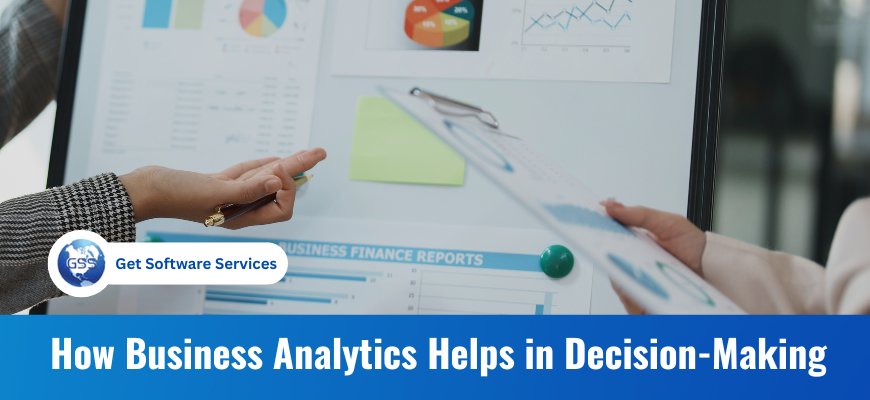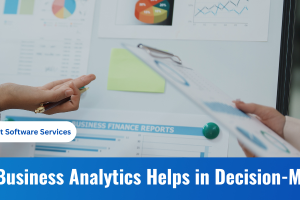
How Business Analytics Helps in Decision-Making
In today’s fast-paced business environment, data and analytics play a crucial role in enhancing strategies and decision-making processes. Consequently, companies that effectively analyze large volumes of data can gain valuable insights that significantly improve their performance. Business analytics employs various methods like statistical analysis, data mining, and predictive modeling to transform raw data into actionable insights. This process is essential for making informed decisions, optimizing operations, and maintaining a competitive edge.
In this article, we will explore the growing importance of data-driven decision-making and its transformative impact on business operations. Moreover, we’ll discuss different techniques used in business analytics, illustrating how they help organizations identify trends, predict future outcomes, and make smarter decisions. Additionally, we’ll offer practical advice on how businesses can start leveraging business analytics, including tips on data selection, tool adoption, and team building. By the end, you’ll have a clear understanding of the power of business analytics and its potential to drive success in today’s dynamic market.
The Rise of Data-Driven Decision-Making
In recent years, businesses have increasingly shifted towards data-driven decision-making, relying more on data than intuition to guide their choices. This approach involves gathering and analyzing information from various sources such as customer feedback, sales data, and social media insights. By reducing guesswork and embracing data-driven insights, organizations can make more informed decisions, achieve better outcomes, and respond faster to market changes.
To effectively implement data-driven decision-making, companies require robust data analysis tools and skilled professionals capable of interpreting complex data sets. Consequently, many organizations invest in specialized software and employ data experts to uncover actionable insights from their data. While this approach significantly enhances efficiency and innovation, it also presents challenges such as ensuring data accuracy and safeguarding privacy. Despite these obstacles, embracing data-driven decision-making represents a significant advancement for businesses aiming to adapt, innovate, and thrive in today’s competitive landscape.
Definition of Business Analytics
Business analytics involves using quantitative methods to assess business performance and inform decision-making processes. By analyzing historical data, businesses can identify patterns and anticipate future trends. This analytical approach relies on mathematics and statistical techniques to derive meaningful insights from vast datasets. For example, businesses may use analytics to understand product performance and customer behavior, enabling more effective planning and decision-making.
Key Components of Business Analytics
In business analytics, three essential components—data collection, analysis, and interpretation—are pivotal in transforming raw data into valuable insights. These components provide a foundation for organizations to strategize effectively, enhance operational efficiency, and foster innovation. Let’s delve into each component to understand how businesses utilize data to solve problems, capitalize on opportunities, and achieve sustained growth.
Components:
- Data Collection: Gathering data from various sources, including internal systems, external databases, and real-time feeds, is the first step. Data quality and accuracy are critical for meaningful analysis. Organizations employ tools like data warehouses, ETL processes (Extract, Transform, Load), and APIs to efficiently collect and store data.
- Data Analysis: Once collected, data undergoes rigorous analysis using statistical methods and algorithms. This process uncovers hidden patterns, correlations, and trends that drive actionable insights. Techniques such as regression analysis, clustering, and machine learning models are employed to extract valuable information.
- Data Interpretation: The final step involves interpreting analyzed data to derive actionable insights. This bridge between data and decision-making is crucial for guiding strategic initiatives. Visualization tools such as dashboards, charts, and graphs play a key role in presenting findings in a clear, accessible format for stakeholders.
mastering business analytics empowers organizations to get the data effectively, enabling informed decision-making, operational excellence, and sustainable growth in today’s competitive business world.
The Impact of Business Analytics
Business analytics plays a crucial role in how companies make decisions and achieve success. Essentially, it involves using data to predict outcomes and improve operations. By effectively analyzing information, businesses can make informed choices that foster growth and enhance customer satisfaction. Understanding the impact of business analytics helps companies remain competitive and adaptable in today’s rapidly evolving market landscape.
Enhanced Competitive Advantage
One of the key benefits of business analytics is its ability to provide a competitive edge. Consequently, organizations that use analytics effectively can outperform their competitors by gaining deeper insights into their markets and operations.
Increased Profits
Business analytics can significantly impact a company’s profitability by optimizing pricing, reducing expenses, and improving resource allocation. When businesses use data to determine optimal pricing for their products or services, they can attract more customers and increase sales effectively. Furthermore, by identifying opportunities to cut costs on supplies and operations through data-driven insights, they can enhance profitability. Another advantage lies in strategically allocating resources based on data analysis, thereby fostering overall business growth and operational efficiency.
Improved Risk Management
Effective risk management is essential for businesses to proactively avoid potential problems. Business analytics provides robust tools for identifying and addressing risks before they escalate. By leveraging data to anticipate challenges, businesses can develop proactive strategies to mitigate risks early on and maintain operational stability.
Selecting the Right Analytical Tools
Choosing the appropriate analytical tools is critical for successfully implementing business analytics. Consequently, organizations need to assess their specific requirements and select tools that meet those needs effectively. Importantly, it is crucial to choose tools capable of efficiently handling large volumes of data. Popular analytics tools such as Tableau, Power BI, SAS, and IBM Watson each offer unique features, so organizations should evaluate them based on their specific needs and capabilities.
Integrating Data Sources and Ensuring Data Quality
Effective business analytics relies on integrating data from various sources while ensuring its accuracy. Additionally, implementing robust data management practices and using tools that facilitate seamless data integration are essential for reliable analysis. For instance, organizations commonly use data warehouses and ETL (Extract, Transform, Load) tools to merge and cleanse data from multiple sources. Moreover, ensuring data quality involves regular validation, cleaning, and updating to maintain reliable and accurate data.
Using Data for Informed Decision-Making
Using high-quality data is crucial for successful business analytics implementation. Furthermore, establishing a culture where data is valued and utilized to make informed decisions across all organizational levels is key to achieving strategic objectives.
Establishing Measurable KPIs
Key Performance Indicators (KPIs) are essential for evaluating the effectiveness of business strategies and initiatives. Moreover, defining clear, data-driven KPIs enables organizations to monitor progress and make informed adjustments. For example, a marketing team might track KPIs such as customer acquisition cost, conversion rate, and return on investment. These metrics provide insights into the success of marketing campaigns and help refine future strategies accordingly.
Monitoring and Analyzing Key Performance Indicators
Regularly monitoring and analyzing KPIs helps organizations track progress and make data-driven decisions about their strategies. Additionally, continuous feedback derived from KPI analysis is crucial for achieving long-term success. Tools such as Google Analytics, Salesforce, and HubSpot provide real-time tracking and reporting capabilities for KPIs, ensuring organizations stay informed and agile in their decision-making processes.
The Future of Business Analytics

The future of business analytics will continue to transform how companies operate. By leveraging data more effectively, businesses can gain deeper insights into customer needs and preferences, resulting in personalized experiences that enhance customer loyalty. Additionally, predictive analytics will play an increasingly important role, enabling businesses to forecast trends and make timely, informed decisions. Furthermore, real-time data analysis will empower companies to respond swiftly to changes in the market.
Emerging Trends and Innovations
Several emerging trends are set to transform business analytics:
- Artificial Intelligence (AI): AI and machine learning algorithms enhance the accuracy and depth of data analysis. Moreover, AI-driven analytics tools automate complex processes, uncover patterns, and provide predictive insights, thereby revolutionizing decision-making capabilities.
- Advanced Predictive Analytics: By using historical data to predict future outcomes, organizations can anticipate sales trends, customer behavior patterns, and potential risks. Consequently, this helps business analytics in decision-making.
- Big Data Analytics: Analyzing vast datasets from diverse sources in real time yields valuable insights. Technologies like Hadoop and Spark enable organizations to process and analyze large datasets quickly and accurately. Consequently, this drives actionable intelligence.
Getting Ready for Changes in Data and Analytics
Data and analytics are constantly evolving, and businesses need to keep up with these changes to stay competitive. This means investing in new technologies, updating employee skills, and staying aware of the latest trends. By being proactive, companies can use data more effectively to make better decisions and improve their operations. Preparing for these changes helps businesses adapt quickly and remain successful in a fast-paced market. Embracing the future of data and analytics is key to long-term growth and success.
Continuous Investment in Technology and Skills
Organizations need to keep investing in the latest analytics technologies and tools to remain competitive. This includes adopting advanced analytics platforms, upgrading existing systems, and integrating new data sources. Providing ongoing education and opportunities for upskilling helps employees stay current with the latest analytics techniques and tools.
Adapting to Emerging Trends and Technologies
Being flexible and adaptable is key to making the most of emerging trends and technologies. This involves keeping an eye on industry developments, participating in relevant conferences and forums, and collaborating with technology partners.
Implementing a Strategic Roadmap for Analytics
Creating a strategic roadmap for analytics helps organizations align their analytics efforts with business goals. This roadmap should outline the organization’s analytics vision, objectives, and key milestones. Additionally, it should include a plan for integrating new technologies, managing data, and measuring the impact of analytics initiatives. Regularly reviewing and updating the roadmap ensures that the organization stays on track and can adapt to changing business needs and technological advancements.
Conclusion
In conclusion, the power of data and business analytics in decision-making is undeniable. By understanding the role of business analytics, using data to make informed decisions, improving operational efficiency, and preparing for the future, organizations can unlock the full potential of their data and achieve long-lasting success. Investing in the right tools, fostering a data-driven culture, and staying ahead of emerging trends are essential steps for any organization looking to harness the power of business analytics.
Ready to learn more about business analytics?
Check out our Business Analytics Course and gain practical skills to use data effectively. This comprehensive course from Get Software Services equips you with the knowledge to tackle challenges, seize opportunities, and lead confidently in today’s data-driven business world. With a focus on real-world applications, you’ll master the techniques needed to analyze data and make informed decisions. Don’t miss this chance to advance your career. Explore our Online Business Analytics Training today and transform your professional journey!



